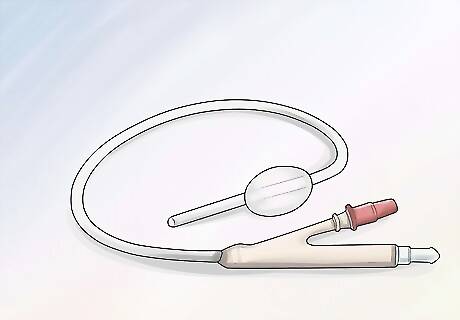
views
Increasing Amniotic Fluid with Medicine

Understand that treatment is based on how far along you are in your pregnancy. The recommendations your doctor will have for treatment will be based on how far along in your pregnancy you are. Generally, your doctor will recommend one of the treatments listed in this section, as well as rehydration at home, which is outlined in the second section of this article. If you are not yet in full term, your doctor will monitor you and your levels very closely. Tests such as non-stress and contraction stress tests may be done to monitor your baby’s activity. Your doctor may also suggest one of the following medical treatments listed in this method. If you are close to full term, your doctor may recommend that you deliver your baby via cesarean section as low amniotic fluid levels right before pregnancy can be dangerous for both you and your baby.

Get an injection of amniotic fluid. In this process, your doctor will inject the leaking amniotic fluids back into the amniotic sac with a needle. This will help your condition because it will increase the amount of amniotic fluid in your uterus. This procedure is a lot like amniocentesis (a way to check your amniotic fluid levels), except that instead of withdrawing the amniotic fluid, the doctor injects the leaking amniotic fluids back into the amniotic sac with a needle. This procedure is often used as a short term fix because amniotic fluid levels tend to drop again after a couple of weeks. However, doctors choose to use this method because it helps them to find the problem that is causing your amniotic fluid levels to be low.

Get fluid intravenously. Some pregnant people are admitted to the hospital for additional intravenous fluid therapy if natural means of rehydration (like drinking lots of water) are not able to increase the amount of amniotic fluid. If you have tried rehydrating at home with no changes in amniotic fluid levels, you will most likely have to get an IV to stay hydrated. Once your amniotic fluid levels are back to normal, you will most likely be discharged. Keep in mind that sometimes IV therapy will continue until you are ready to give birth if you are having troubles staying hydrated.

Use a catheter to increase fluid levels. Amnioinfusion is when Lactated Ringer’s Solution or a regular saline solution is infused into the amniotic fluid sac by a catheter. Doing this increases the amniotic fluid levels around your baby and provides extra padding for your baby and the umbilical cord. The amount of saline injected will depend on how low your amniotic fluid levels are.

Talk to your doctor about having a shunt placed in your body. Shunts are used to move body fluid from one place in your body to another. In this case, a shunt diverts fetal urine into your amniotic fluid cavity if the reason you have low amniotic fluid levels is because of fetal obstructive uropathy (kidney problems that decrease amniotic fluid).
Increasing Amniotic Fluid with Home Management

Drink at least 8 to 10 glasses of water each day. One of the simplest ways to increase your amniotic fluid is to make sure that you are always hydrated. When you increase the amount of water you have in your body, your amniotic fluid levels will also rise. Drink water throughout the day and try to drink at least 8 to 10 glasses at a minimum.

Eat fruits that have water contents. A great way to stay hydrated while also getting good nutrients is to eat fruits and vegetables that have high water concentrations. As stated above, when you increase the amount of hydration your body gets, you will also increase the amount of amniotic fluid you have. Good fruits and vegetables to eat when needing hydration include: Vegetables like: Cucumber (96.7% water), iceberg lettuce (95.6%), celery (95.4%), radishes (95.3%), green peppers (93.9%), cauliflower (92.1%), spinach (91.4%), broccoli (90.7%), and baby carrots (90.4%). Fruits like: Watermelon (91.5%), tomatoes (94.5%), star fruit (91.4%), strawberries (91.0%), grapefruit (90.5%), and cantaloupe (90.2%).

Avoid herbal supplements that can dehydrate you. Some herbal supplements can act as diuretics that make you have to urinate more. The more you go to the bathroom, the likelier you are to become dehydrated. It is very important that you stay hydrated when you are concerned about your levels of amniotic fluid. Herbal supplements to stay away from include: Dandelion extract, celery seed, watercress, and parsley.

Stay away from alcohol. If you are pregnant, you should not drink alcohol at all because it is not good for your baby’s health. Alcohol can also dehydrate you and cause your amniotic fluid levels to shrink.

Do light exercise regularly if your doctor has not asked you to get bed rest. You should try to get at least 30 to 45 minutes of non-weight bearing exercise every day. Exercises promote an increased blood flow to the different areas in your body. If there is an increased blood circulating in the uterus and placenta, there is also an increase in the amniotic fluid index and fetal urine production rate (the amount your baby urinates). As your baby passes more urine in the amniotic sac, the volume of the amniotic fluid increases. Exercises you should consider doing include: Swimming or water aerobics. These are the best exercises to do when you are pregnant because it takes all the weight of your baby off of you. Walking and light hiking.

Lie on your left side when you relax. If your doctor has asked you to stay in bed (what is referred to as complete bed rest) you should lay on your left side when you can. When you lie on your left side, your blood flows more smoothly through the uterine blood vessels and allows your baby’s blood flow to also move at a regular rate. This may cause the amniotic fluid index to rise.

Talk to your doctor about changing your prescription if you are taking Angiotensin Converting Enzyme Inhibitors (ACE). ACE inhibitors are medications that help to lower your high blood pressure by stopping your body’s conversion of Angiotensin I to Angiotensin II. While it is normally good to take these medications, you should not take them while you are pregnant because they can lower the amount of amniotic fluid that your body creates.
Understanding Oligohydramnios

Understand what amniotic fluid’s purpose is. The most important thing that amniotic fluid does is keep your baby safe while he or she is in the womb. It does this by cushioning your baby. It also has other functions, which include: Keeping the baby warm. Acting as a lubricant. Promoting proper lung and kidney development. Helping the baby move freely, which in turn lets him/her exercise the limbs and become strong.

Be aware of the symptoms of oligohydramnios. Oligohydramnios is the condition that occurs when your amniotic fluid gets very low (specifically below 300 ml). If you are concerned that you might have developed this condition, you should always talk to your doctor. If you are concerned you might develop the condition in the future, it is helpful to know what to look for. Symptoms include: Leakage of amniotic fluid. Your abdomen is smaller than you think it should be given your gestational period (how long you have been pregnant). Feeling like your baby is moving around less. Smaller than expected urine amounts when you go to the bathroom. Visible lack of amniotic fluid when you get an ultrasound.

Be aware of the risk factors that could lead you to having low amounts of amniotic fluid. There are some conditions or factors that can predispose you to having troubles with your amniotic fluid amounts. Some of the more common reasons include: If your baby is small for his or her gestational age. If you have high blood pressure while you are pregnant (a condition called pre-eclampsia). If your placenta partially or completely peels away from your uterine wall even before the onset of delivery. This condition is known as abruptio placenta. If you are having identical twins. If identical twins share a placenta, sometimes their amniotic fluid levels become out of balance. This happens when one twin gets more blood via the placenta than the other. If you have certain medical conditions like lupus. If you are in post-term pregnancy. If your pregnancy has gone over 42 weeks, you have a higher risk of low levels of amniotic fluid due to declining placental function – amniotic fluid starts to decrease by the 38th week of pregnancy.

Understand that low levels of amniotic fluid can generally only be diagnosed by ultrasound. The actual volume of amniotic fluid cannot be safely measured directly so the condition is diagnosed by using ultrasounds that check the amniotic fluid index (AFI). A normal AFI range is between 5 and 25 cm.


















Comments
0 comment